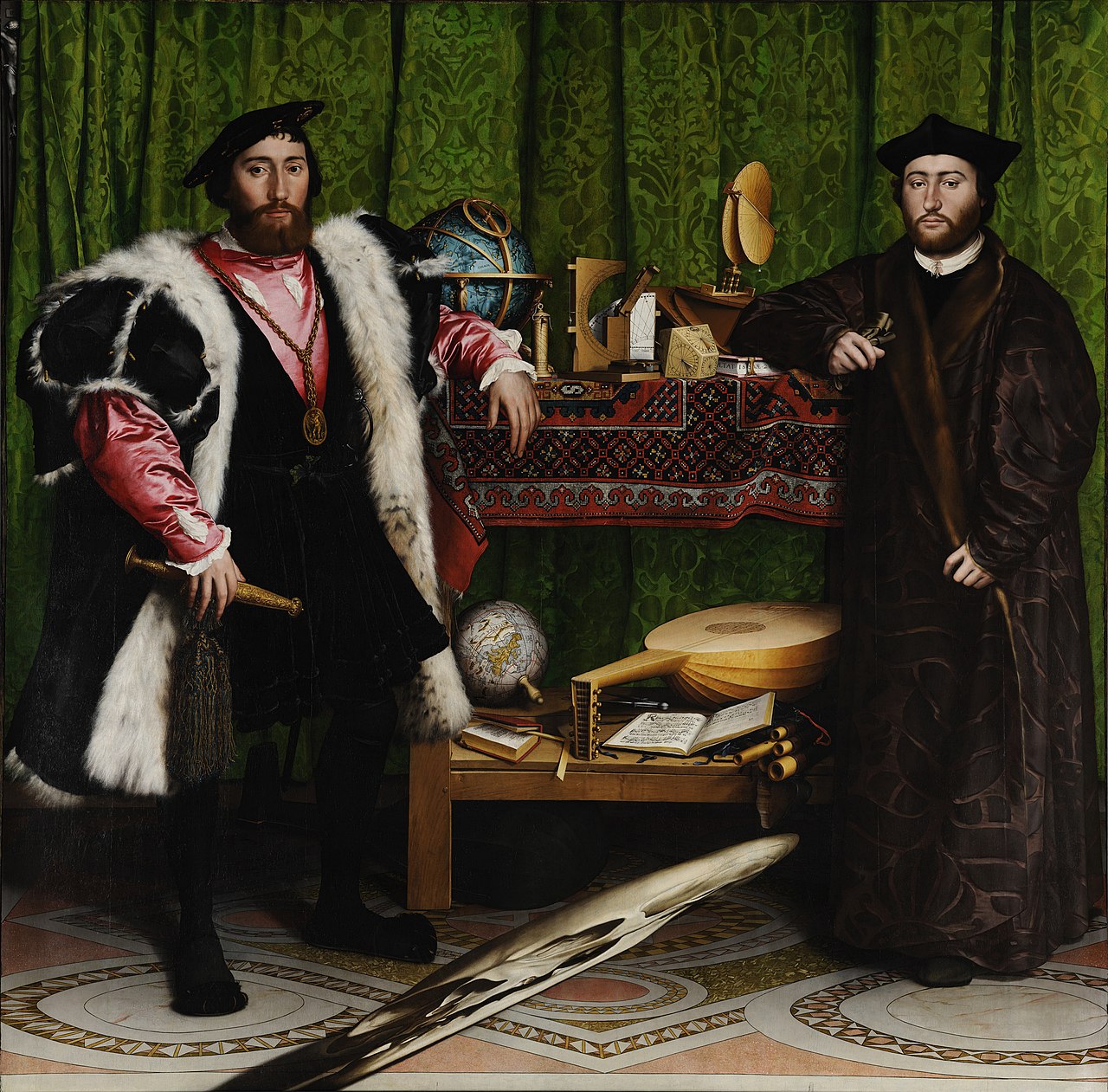
ホルバインの「大使たち」
Hans Holbein the Younger's The
Ambassadors

☆ 『大使たち』(The Ambassadors)は、ハンス・ホルベイン(Hans Holbein the Younger)による1533年の絵画。描かれた2人の人物にちなんで、ジャン・ド・ディンテヴィルとジョルジュ・ド・セルヴとも呼ばれ、チューダー朝時代、エリザベス1世が生まれた年に 制作された。フラニー・モイルは、エリザベスの母で当時イングランド女王だったアン・ブーリンが、左側に描かれた大使ジャン・ド・ダンティーヴィルへの贈 り物としてこの作品を注文したのではないかと推測している。二重の肖像画であると同時に、この絵には細密に描かれた物体の静物画が含まれており、その意味については多くの議論がある。絵画におけるアナモルフォシス の最もよく知られた例のひとつである。『大使たち』は、1890年に購入されて以来、ロンドンのナショナル・ギャラリーに収蔵されている。
| The Ambassadors is a 1533 painting by Hans Holbein the Younger. Also known as Jean de Dinteville and Georges de Selve,[1] after the two people it portrays, it was created in the Tudor period, in the same year Elizabeth I was born. Franny Moyle speculates that Elizabeth's mother, Anne Boleyn, then Queen of England, might have commissioned it as a gift for Jean de Dinteville, the ambassador portrayed on the left.[2] As well as being a double portrait, the painting contains a still life of meticulously rendered objects, the meaning of which is the cause of much debate. It incorporates one of the best-known examples of anamorphosis in painting. The Ambassadors has been part of London's National Gallery collection since its purchase in 1890. https://en.wikipedia.org/wiki/The_Ambassadors_(Holbein) |
『大使たち』(The Ambassadors)は、ハンス・ホルベイン(Hans Holbein the Younger)による1533年の絵画。 描かれた2人の人物にちなんで、ジャン・ド・ディンテヴィルとジョルジュ・ド・セルヴとも呼ばれ[1]、チューダー朝時代、エリザベス1世が生まれた年に 制作された。フラニー・モイルは、エリザベスの母で当時イングランド女王だったアン・ブーリンが、左側に描かれた大使ジャン・ド・ダンティーヴィルへの贈 り物としてこの作品を注文したのではないかと推測している[2]。 二重の肖像画であると同時に、この絵には細密に描かれた物体の静物画が含まれており、その意味については多くの議論がある。絵画におけるアナモルフォシス の最もよく知られた例のひとつである。『大使たち』は、1890年に購入されて以来、ロンドンのナショナル・ギャラリーに収蔵されている。 |
| Anamorphosis
is a distorted projection that requires the viewer to occupy a specific
vantage point, use special devices, or both to view a recognizable
image. It is used in painting, photography, sculpture and installation,
toys, and film special effects. The word is derived from the Greek
prefix ana-, meaning "back" or "again", and the word morphe, meaning
"shape" or "form". Extreme anamorphosis has been used by artists to
disguise caricatures, erotic and scatological scenes, and other furtive
images from a casual spectator, while revealing an undistorted image to
the knowledgeable viewer.[1] https://en.wikipedia.org/wiki/Anamorphosis |
ア
ナモルフォシスとは、歪んだ投影のことで、認識可能なイメージを見るためには、見る人が特定の見晴らしの良い場所を占めるか、特別な装置を使うか、あるい
はその両方を必要とする。絵画、写真、彫刻、インスタレーション、玩具、映画の特殊効果などに用いられる。語源は、ギリシャ語で「戻る」や「再び」を意味
する接頭辞ana-と、「形」や「形態」を意味するmorpheである。極端なアナモルフォシスは、風刺画やエロチックなシーン、スカトロなシーンなど、
何気なく見ている人たちからは気取ったイメージを、知識のある鑑賞者には歪みのないイメージを見せるために、芸術家によって使われてきた[1]。 |
| Description Though he was a German-born artist who spent much of his time in England, Holbein here displays the influence of Early Netherlandish painting. He used oils which for panel paintings had been developed a century before in Early Netherlandish painting, and just as Jan van Eyck and the Master of Flémalle used extensive imagery to link their subjects to religious concepts, Holbein used symbolic objects around the figures to suggest mostly secular ideas and interests.  Holbein carpet with large medallions, of a type similar to that of the painting, 16th century, Central Anatolia Among the clues to the figures' associations are a selection of scientific instruments including two globes (one terrestrial and one celestial), a shepherd's dial, a quadrant, a torquetum, and a polyhedral sundial,[3] as well as various textiles including the floor mosaic, based on a design from Westminster Abbey (the Cosmati pavement, before the High Altar), and the carpet on the upper shelf, an example of Oriental carpets in Renaissance painting. The figure on the left is in secular attire while the figure on the right is dressed in clerical clothes. They flank the table, which displays open books and symbols of religious knowledge, including a symbolic link to the Virgin. Near the top left corner, a crucifix can be seen, partially covered by the curtain. 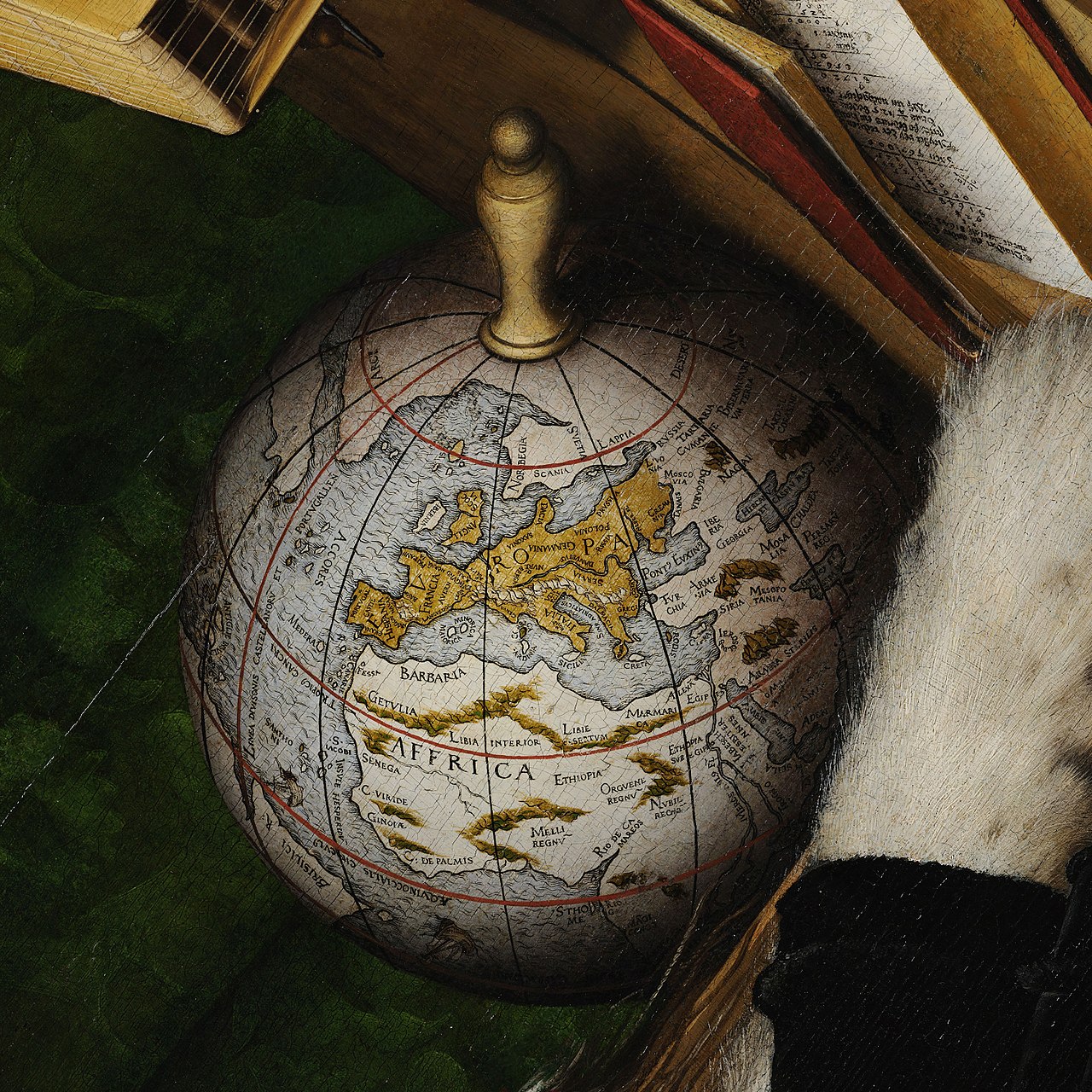 The Ambassadors' globe (detail) In contrast, other scholars have suggested the painting contains overtones of religious strife. The conflicts between secular and religious authorities are here represented by Jean de Dinteville, a landowner, and Georges de Selve, the Bishop of Lavaur. The commonly accepted symbol of discord, a lute with a broken string, is included next to a hymnbook in Martin Luther's translation, suggesting strife between scholars and the clergy.[4] For others, if the lute's broken string suggests the interruption of religious harmony, the Lutheran hymnal, open on facing pages reproducing a song on the Commandments (Law) and one on the Holy Spirit (Grace) may suggest their being in "harmony" with each other.[5] The terrestrial globe on the lower shelf repeats a portion of a cartographically imaginative map created in possibly 1530 and of unknown origin. The map is referred to as the Ambassadors' Globe due to its popularly known appearance in the painting.[6][7] The work has been described as "one of the most staggeringly impressive portraits in Renaissance art."[8] |
解説 ホルバインはドイツ生まれの画家であり、多くの時間をイギリスで過ごしたが、ここでは初期ネーデルラント絵画の影響が見られる。また、ヤン・ファン・エイ クやフレマールの巨匠が、主題を宗教的概念に結びつけるために広範なイメージを用いたように、ホルベインもまた、人物の周囲に象徴的なものを用いて、主に 世俗的な思想や関心を示唆している。  大きなメダリオンが描かれたホルベインの絨毯(16世紀、中央アナトリア地方)。 人物の関連性を示す手がかりの中には、2つの地球儀(1つは地球儀、もう1つは天球儀)、羊飼いの文字盤、四分儀、トルケトゥム、多面体の日時計[3]を 含む科学用具の数々や、ウェストミンスター寺院のデザインに基づく床のモザイク(大祭壇の前にあるコスマティ敷き)、ルネサンス絵画における東洋絨毯の一 例である上段の絨毯を含む様々な織物がある。左側の人物は世俗的な服装で、右側の人物は聖職者の服装をしている。二人はテーブルを挟んでおり、そこには開 かれた書物と、聖母への象徴的なつながりを含む宗教的知識の象徴が展示されている。左上隅近くには、カーテンで部分的に覆われた十字架が見える。  大使たちの地球儀(詳細) これとは対照的に、この絵には宗教的抗争の含みがあると指摘する学者もいる。世俗的権威と宗教的権威の対立は、ここでは地主のジャン・ド・ディンテヴィル とラヴォール司教のジョルジュ・ド・セルヴによって表現されている。一般に不和の象徴とされている弦の切れたリュートが、マルティン・ルター訳の賛美歌集 の隣に置かれているのは、学者と聖職者の間の争いを暗示している[4]。リュートの弦が切れているのが宗教的な調和の中断を暗示しているとすれば、ルター 派の賛美歌集は、戒律(律法)に関する歌と聖霊(恩寵)に関する歌を再現した見開きのページを開いており、互いに「調和」していることを暗示しているのか もしれない[5]。 下棚の地球儀は、おそらく1530年に作成された、出所不明の地図学的に想像力豊かな地図の一部を繰り返している。この地図は、絵の中に登場することが一般に知られているため、「大使たちの地球儀」と呼ばれている[6][7]。 この作品は「ルネサンス美術の中で最も驚異的で印象的な肖像画のひとつ」と評されている[8]。 |
Anamorphic skull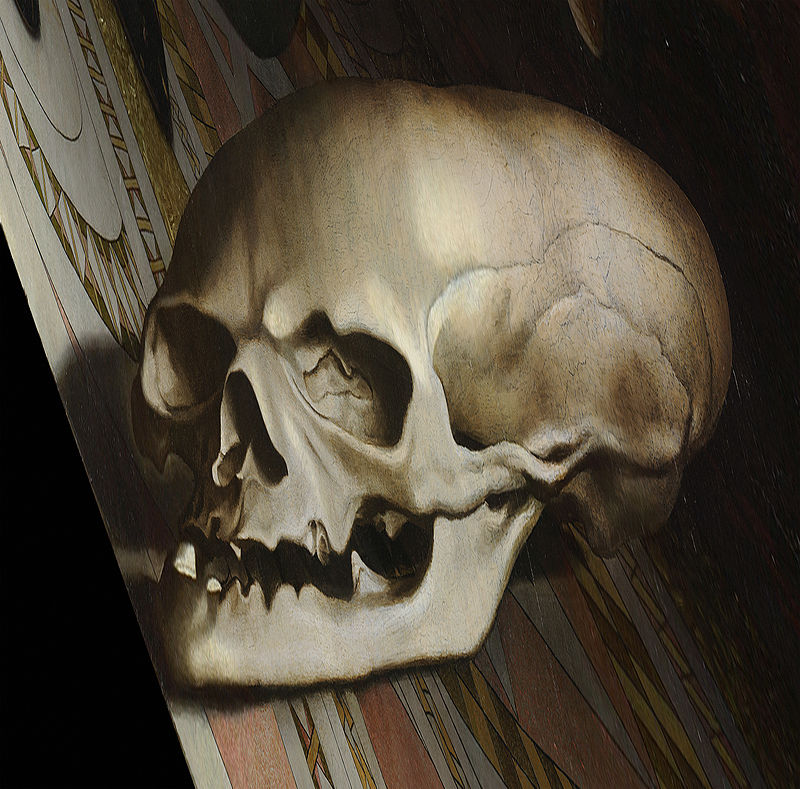 The anamorphic skull as restored in 1998, viewed here at an oblique angle The most notable and famous of Holbein's symbols in the work is the distorted skull which is placed in the bottom centre of the composition. The skull, rendered in anamorphic perspective, another invention of the Early Renaissance, is meant to be a visual puzzle as the viewer must approach the painting from high on the right side, or low on the left side, to see the form as an accurate rendering of a human skull. While the skull is evidently intended as a vanitas or memento mori, it is unclear why Holbein gave it such prominence in this painting. A simple explanation is that "memento mori" was de Dinteville's motto,[9] while another possibility is that this painting represents three levels: the heavens as portrayed by the astrolabe and other objects on the upper shelf, the living world as evidenced by books and a musical instrument on the lower shelf, and death signified by the skull. It has also been hypothesized that the painting was meant to hang beside a doorway, or even in a stairwell, so that persons entering the room or walking up the stairs and passing the painting on their left would be confronted by the appearance of the skull. A further possibility is that Holbein simply wished to show off his ability with the technique in order to secure future commissions.[10] However, artists often incorporated skulls as a reminder of mortality. Holbein may have intended the skulls (one as a gray slash and the other as a medallion on Jean de Dinteville's hat) and the crucifix in the upper left corner to encourage contemplation of one's impending death and the resurrection.[4] |
アナモルフィック頭蓋骨 1998年に修復されたアナモルフィック・ドクロ。 この作品におけるホルバインのシンボルの中で最も注目され、有名なのは、構図の中央下に配置された歪んだ頭蓋骨である。初期ルネサンスのもうひとつの発明 であるアナモルフィック遠近法で描かれたこの頭蓋骨は、視覚的なパズルを意図しており、鑑賞者は右側の高い位置から、あるいは左側の低い位置から絵に近づ かなければ、この形を人間の頭蓋骨の正確な描写として見ることができない。この頭蓋骨がヴァニタスあるいはメメント・モリとして意図されていることは明ら かだが、なぜホルバインがこの絵の中で頭蓋骨をこれほど目立たせたのかは不明である。単純な説明としては、「メメント・モリ」はド・ディンテヴィルのモッ トーであったという説[9]があるが、別の可能性としては、この絵は3つのレベルを表現しているという説がある。すなわち、上段の棚にある天文台やその他 のオブジェが描く天界、下段の棚にある書物や楽器が示す生者の世界、そして髑髏が意味する死である。 また、この絵は出入り口の脇、あるいは階段の吹き抜けに飾られることを意図しており、部屋に入る人、あるいは階段を上って絵の左側を通る人は、髑髏の出現 に直面することになる、という仮説もある。さらに考えられるのは、ホルバインは単に将来の依頼を確保するために、この技法で自分の能力を誇示したかったと いうことである[10]。しかし、芸術家はしばしば死を思い起こさせるものとして髑髏を取り入れた。ホルバインは、髑髏(1つは灰色の切り裂き、もう1つ はジャン・ド・ディンテヴィルの帽子のメダイヨン)と左上の十字架を、間近に迫った死と復活について考えることを促す意図で描いたのかもしれない[4]。 |
| Identity of the subjects Before the publication of Mary F. S. Hervey's Holbein's Ambassadors: The Picture and the Men in 1900, the identity of the two figures in the picture had long been a subject of intense debate. In 1890, Sidney Colvin was the first to propose the figure on the left as Jean de Dinteville, Seigneur of Polisy (1504–1555), French ambassador to the court of Henry VIII for most of 1533. Shortly afterwards, the cleaning of the picture revealed that his seat of Polisy is one of only four French places marked on the globe.[11] Hervey identified the man on the right as Georges de Selve (1508/09–1541), Bishop of Lavaur, after tracing the painting's history back to a seventeenth-century manuscript. According to art historian John Rowlands, de Selve is not wearing episcopal robes because he was not consecrated until 1534.[12] De Selve is known from two of de Dinteville's letters to his brother François de Dinteville, Bishop of Auxerre, to have visited London in the spring of 1533. On 23 May, Jean de Dinteville wrote: "Monsieur de Lavaur did me the honour of coming to see me, which was no small pleasure to me. There is no need for the grand maître to hear anything of it". The grand maître in question was Anne de Montmorency, the Marshal of France, a reference that has led some analysts to conclude that de Selve's mission was a secret one; but there is no other evidence to corroborate the theory.[13] On June 4, the ambassador wrote to his brother again, saying: "Monsieur de Lavaur came to see me, but has gone away again".[14]  Lutheran Psalmbook in The Ambassadors Hervey's identification of the sitters has remained the standard one, affirmed in extended studies of the painting by Foister, Roy, and Wyld (1997), Zwingenberger (1999), and North (2004), who concludes that "the general coherence of the evidence assembled by Hervey is very satisfying"; however, North also notes that, despite Hervey's research, "Rival speculation did not stop at once and is still not entirely dead".[15] Giles Hudson, for example, has argued that the man on the right is not de Selve, but Jean's brother François, Bishop of Auxerre, a noted patron of the arts with a known interest in mathematical instruments.[16] The identification finds support in the earliest manuscript in which the painting is mentioned, a 1589 inventory of the Chateau of Polisy, discovered by Riccardo Famiglietti. However, scholars have argued that this identification of 1589 was incorrect. John North, for example, remarks that "This was a natural enough supposition to be made by a person with limited local knowledge, since the two brothers lived on the family estates together at the end of their lives, but it is almost certainly mistaken".[17] He points to a letter François de Dinteville wrote to Jean on 28 March 1533, in which he talks of an imminent meeting with the Pope and makes no mention of visiting London. Unlike the man on the right of the picture, François was older than Jean de Dinteville. The inscription on the man on the right's book is "AETAT/IS SV Æ 25" (his age is 25); that on de Dinteville's dagger is "AET. SV Æ/ 29" (he is 29).[18] North's book analyzes the painting and shows it to be representing Good Friday through various clues on the instruments.[3] |
主題の正体 1900年にメアリー・F・S・ハーヴェイの『ホルバインの大使たち』が出版される以前は、この絵に描かれている二人の人物の正体について、長い間激しい 論争が繰り広げられていた: 1900年にMary F. S. Herveyの『The Picture and the Men』が出版されるまで、この絵に描かれた二人の人物の同一性については、長い間激しい論争の的となっていた。1890年、シドニー・コルヴァンは、左 側の人物が1533年の大半をヘンリー8世の宮廷で過ごしたフランス大使、ジャン・ド・ディンテヴィル(ポリシーの君主、1504-1555年)であると 最初に提唱した。その後間もなく、絵の洗浄が行われ、彼の居城ポリジーは、地球儀に記された4つのフランスの地名のうちの1つであることが判明した [11]。ハーヴェイは、絵の歴史を17世紀の写本まで遡り、右の人物をラヴォール司教ジョルジュ・ド・セルヴェ(1508/09-1541)と特定し た。美術史家ジョン・ローランズによれば、ド・セルヴェが司教服を着ていないのは、彼が1534年まで司教に任命されていなかったからである[12]。 ド・セルヴェは、ド・ディンテヴィルが弟のフランソワ・ド・ディンテヴィル(オセール司教)に宛てた2通の手紙から、1533年の春にロンドンを訪れてい たことが分かっている。5月23日、ジャン・ド・ディンテヴィルは、「ムッシュー・ド・ラヴォールが私に会いに来てくれたことは、私にとって小さな喜びで はなかった。グランド・マイスターには何も聞かせる必要はない」。フランス元帥アンヌ・ド・モンモランシーのことを指しており、ドゥ・セルヴの使節団は極 秘のものであったと結論づける分析家もいるが、この説を裏付ける証拠は他にない[13]。 6月4日、大使は兄に再び手紙を書き、こう述べた: 「ムッシュー・ド・ラヴォールは私に会いに来たが、またどこかに行ってしまった」[14]。  大使たち』におけるルター派の聖歌詩篇 ハーヴェイの同定は、フォイスター、ロイ、ウィルド(1997年)、ツヴィンゲンベルガー(1999年)、ノース(2004年)らによるこの絵画の大規模 な研究において、「ハーヴェイによって収集された証拠の一般的な一貫性は非常に満足のいくものである」と結論づけられている。 [15] ジャイルズ・ハドソン(Giles Hudson)などは、右の人物はド・セルヴではなく、ジャンの弟で、数学の道具に興味を持ち、芸術のパトロンとして知られたオセール司教のフランソワで あると主張している。しかし、学者たちは、1589年の同定は誤りであると主張してきた。例えば、ジョン・ノースは、「2人の兄弟が生涯の終わりに一族の 領地で共に暮らしたのだから、地元の知識に乏しい者がこの推測をするのは十分自然なことだが、ほぼ間違いない」と述べている[17]。彼は、フランソワ・ ド・ディンテヴィルが1533年3月28日にジャンに宛てた手紙を指摘しており、その手紙には、ローマ教皇との面会が間近に迫っていることが書かれてお り、ロンドンを訪れることについては触れられていない。フランソワは写真右の男とは異なり、ジャン・ド・ディンテヴィルよりも年上であった。右の男の書物 の銘は "AETAT/IS SV Æ 25"(彼の年齢は25歳)、ド・ディンテヴィルの短剣の銘は "AET. SV → 29」(彼は29歳)である[18]。 ノースの本はこの絵を分析し、楽器に描かれた様々な手がかりから聖金曜日を表していることを示す[3]。 |
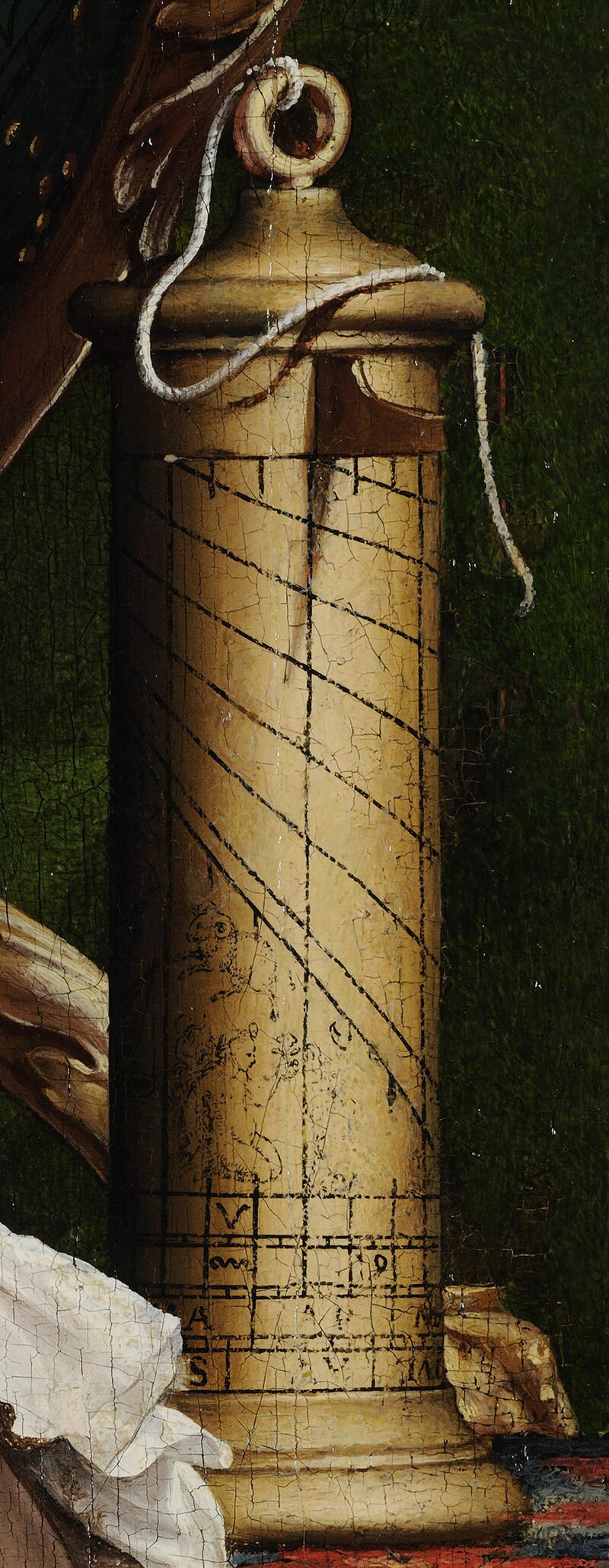 A
shepherd's dial (also known as a pillar dial or cylinder) is a type of
sundial that measures the height of the sun via the so-called umbra
versa.[1] Its design needs to incorporate a fixed latitude, but it is
small and portable. It is named after Pyrenean shepherds, who would
trace such a sundial on their staffs. This type of sundial was very
popular in the 16th, 17th, and 18th centuries. A
shepherd's dial (also known as a pillar dial or cylinder) is a type of
sundial that measures the height of the sun via the so-called umbra
versa.[1] Its design needs to incorporate a fixed latitude, but it is
small and portable. It is named after Pyrenean shepherds, who would
trace such a sundial on their staffs. This type of sundial was very
popular in the 16th, 17th, and 18th centuries.https://en.wikipedia.org/wiki/Shepherd%27s_dial |
シェ
パード・ダイヤル(ピラー・ダイヤル、シリンダー・ダイヤルとも呼ばれる)は、いわゆるアンブラ・バーサによって太陽の高さを測る日時計の一種である
[1]。ピレネーの羊飼いたちがこのような日時計を杖につけていたことにちなんで名付けられた。このタイプの日時計は、16世紀、17世紀、18世紀に非
常に人気があった。 |
 Universal equinoctial dial (disassembled, front) and Quadrant (rear) Universal equinoctial dial (disassembled, front) and Quadrant (rear) |
ユニバーサル赤道儀(分解可能、前)と象限儀(後) |
 Polyhedral sundial Polyhedral sundial |
多面体日時計 |
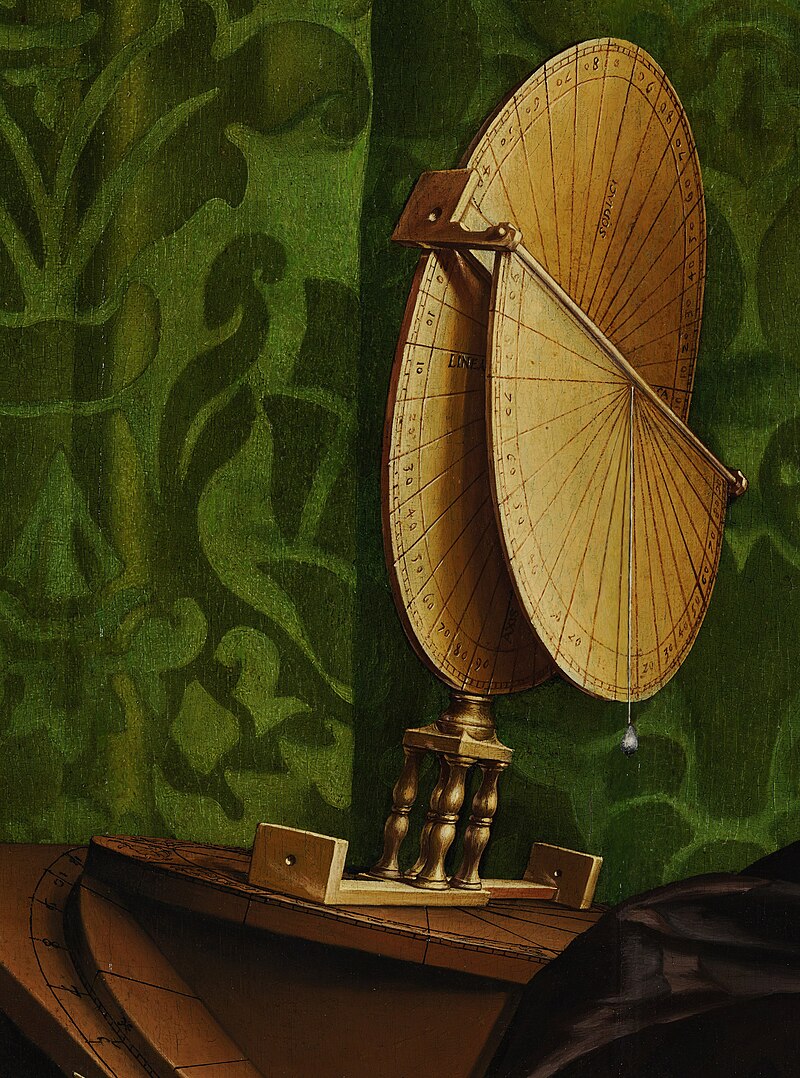 Torquetum Torquetum |
トルクエタム(英: Torquetum, Turquet)は、中世の天文学用機器であり、地平座標、赤道座標、黄道座標という3種類の座標系の測定値の相互変換に用いられた。アナログコンピュータの一種とされることもある。 |
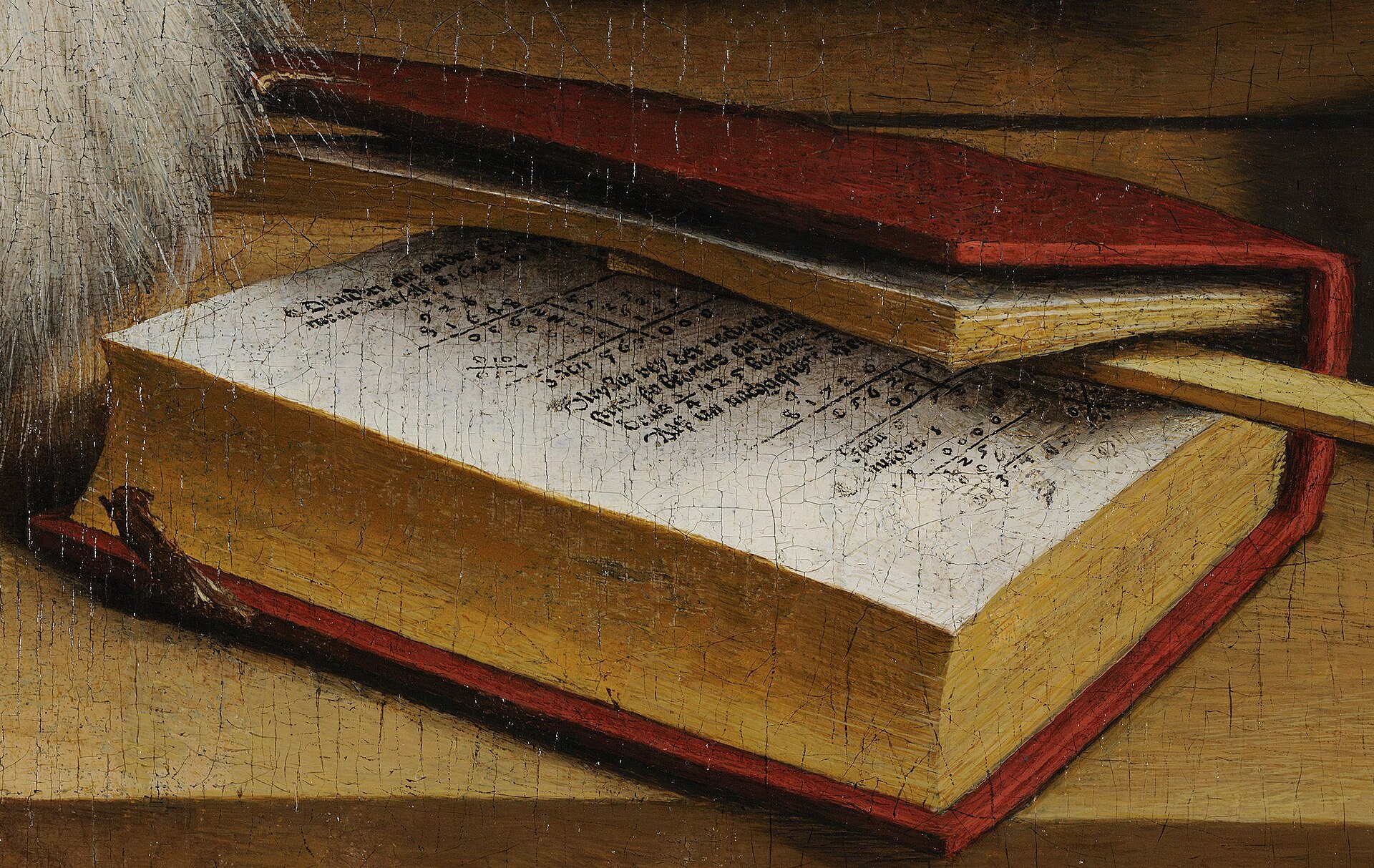 Peter Apian's arithmetic book Peter Apian's arithmetic book |
ピーター・アピアンの算術書 |
| Artists of the Tudor court List of paintings by Hans Holbein the Younger |
|
| https://en.wikipedia.org/wiki/The_Ambassadors_(Holbein) |
|
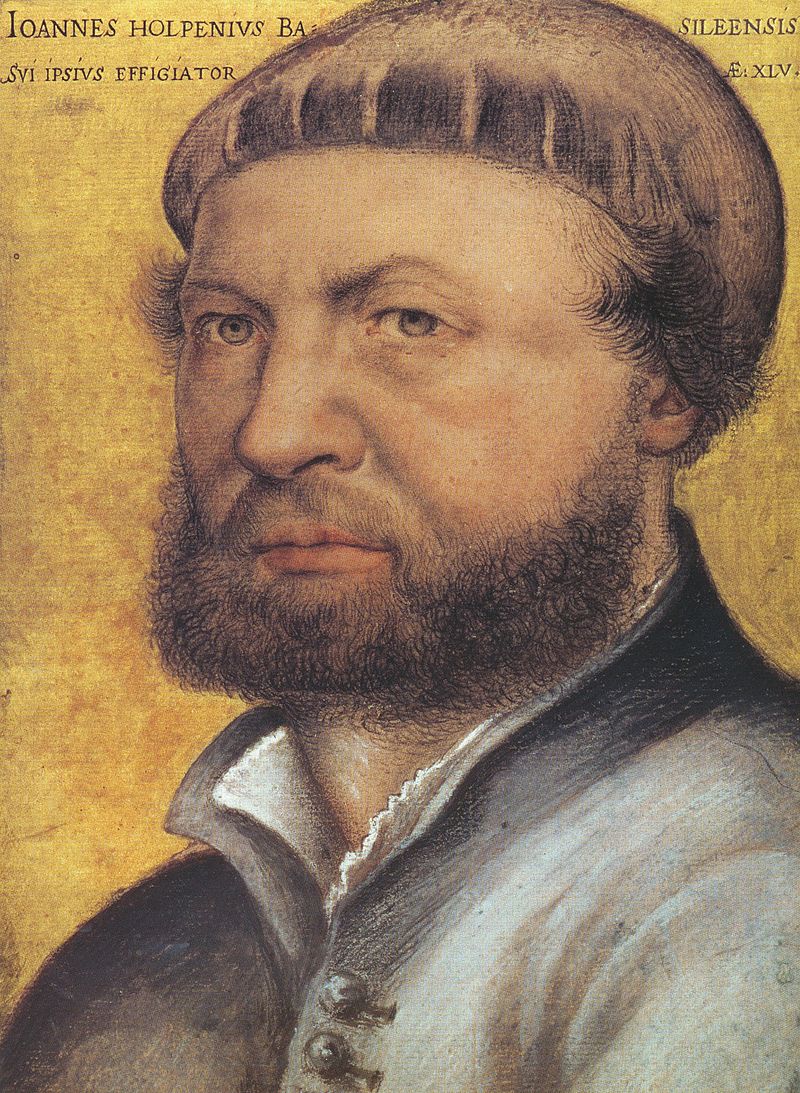 Hans Holbein the Younger
(c. 1497–1543) was a German artist and printmaker who worked in a
Northern Renaissance style. He is best known as one of the greatest
portraitists of the 16th century.[1] He also made a significant
contribution to the history of book design, and produced religious art,
satire, and Reformation propaganda. Hans Holbein the Younger
(c. 1497–1543) was a German artist and printmaker who worked in a
Northern Renaissance style. He is best known as one of the greatest
portraitists of the 16th century.[1] He also made a significant
contribution to the history of book design, and produced religious art,
satire, and Reformation propaganda.Born in Augsburg, Holbein worked mainly in Basel as a young artist, painting murals and religious works and drawing designs for stained glass and printed books. He produced the occasional portrait, and made his international mark with portraits of the famous humanist Desiderius Erasmus of Rotterdam. When the Reformation reached Basel, Holbein produced works for reformist clients while continuing to serve traditional religious patrons. His late-Gothic style was influenced by artistic trends in Italy, France and the Netherlands, as well as by Renaissance humanism, resulting in a combined aesthetic that was uniquely his own. Holbein travelled to England in 1526 in search of work, armed with a recommendation from Erasmus. He was welcomed into the humanist circle of Thomas More, where he soon built a high reputation. After returning to Basel for four years, in 1532 he resumed his career in England, where he worked for Anne Boleyn and Thomas Cromwell, and was appointed King's Painter to Henry VIII. In this role, he produced designs for jewellery, plate, and other precious objects, as well as for festive decorations. His portraits of the king and his family and courtiers provide a vivid record of a brilliant court, during a momentous period when Henry was assuming power as the Supreme Head of the English church. https://en.wikipedia.org/wiki/List_of_paintings_by_Hans_Holbein_the_Younger |
ハ
ンス・ホルバイン(Hans Holbein the Younger,
1497-1543)は、北方ルネサンス様式のドイツ人画家・版画家。16世紀最大の肖像画家の一人として知られ[1]、書籍デザインの歴史にも大きく貢
献し、宗教画、風刺画、宗教改革プロパガンダを制作した。 アウクスブルクに生まれたホルバインは、若い頃は主にバーゼルで活動し、壁画や宗教作品を描いたり、ステンドグラスや印刷された本のデザインを描いたりし た。時折肖像画も制作し、有名な人文主義者デジデリウス・エラスムス(ロッテルダム)の肖像画で国際的な名声を得た。宗教改革がバーゼルに伝わると、ホル ベインは伝統的な宗教的パトロンへの奉仕を続けながら、改革派のクライアントのために作品を制作した。彼の後期ゴシック様式は、ルネサンス期の人文主義だ けでなく、イタリア、フランス、オランダの芸術動向からも影響を受けており、その結果、彼独自の美学が融合したものとなった。 ホルベインは1526年、エラスムスの推薦状を携えて仕事を求めてイギリスに渡った。トマス・モアの人文主義のサークルに迎えられ、すぐに高い評判を得 る。バーゼルに4年間戻った後、1532年にイングランドで活動を再開し、アン・ブーリンやトーマス・クロムウェルのもとで働き、ヘンリー8世の国王画家 に任命された。この職務において、彼は宝飾品、皿、その他の貴重品、祝祭の装飾品のデザインを手がけた。彼が描いた国王とその家族、廷臣たちの肖像画は、 ヘンリーが英国教会の最高責任者として権力を握りつつあった重要な時期に、華麗な宮廷を生き生きと記録している。 |
リ ンク
文 献
そ の他の情報
Copyleft, CC, Mitzub'ixi Quq Chi'j, 1996-2099
☆ ☆
☆